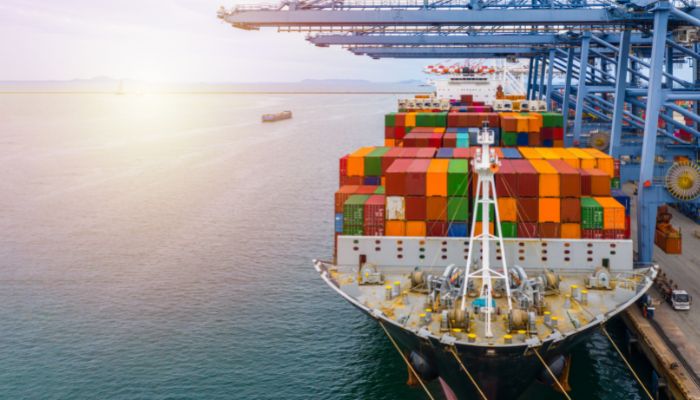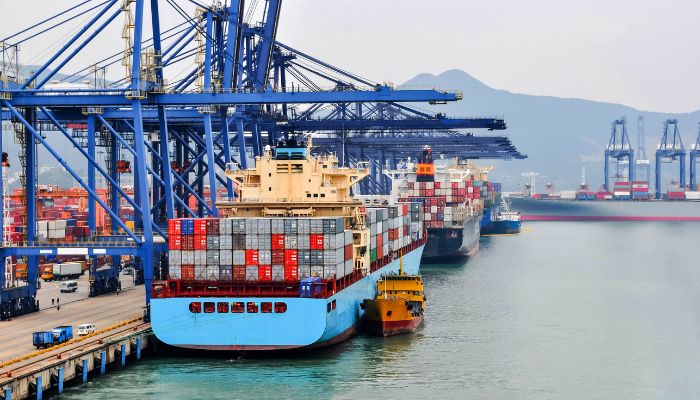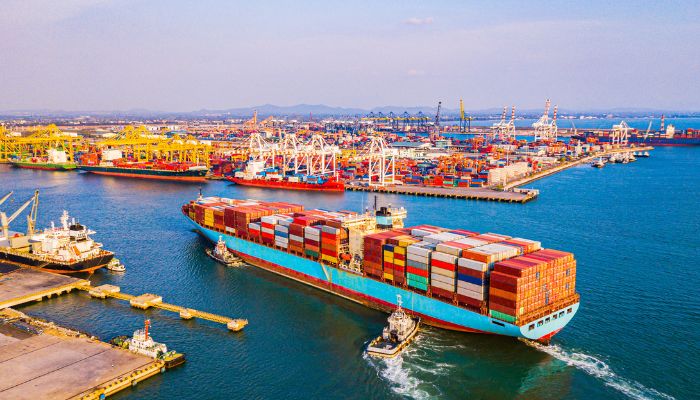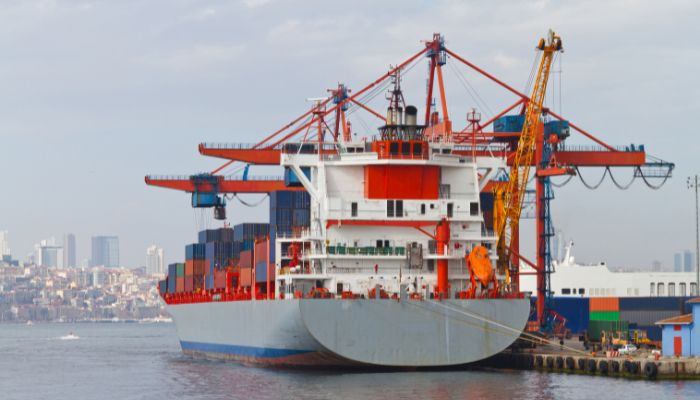Advantages And Disadvantages Of Bigger Vessels For Container Carriers And Ship Owners
Over the past decade, the shipping industry has undergone a revolution in scale, with vessel sizes increasing exponentially.
After hovering around the 10,000 TEUs mark for the better part of the first decade of 2000, a new record was set by Maersk Line with the deployment of its 13,000 TEU E-Class vessels in 2013. A few years later, Maersk Line inducted the new Triple E series of ships of 18,000 TEU capacity in its fleet.
Since then, other carriers have also jumped onto the bandwagon and ordered increasingly bigger vessels. The largest container vessel currently afloat has a carrying capacity of just over 24,000 TEUs (Ever A Lot, operated by Evergreen, nominal capacity of 24,004 TEUs).
The necessity of owning and operating these mega vessels (also called ULCCs and VLCCs), especially on the Asia-Europe trade, to bridge the gap with competitors and garner benefits of scale and lower slot costs (which in turn will enable carriers to offer more competitive rates or even engage in rate wars to grab market share) have compelled carriers of all sizes to invest in larger vessels, with even the smaller global carriers such as HMM placing orders for ULCCs.
Having understood the current situation and the historical context, we will explore in detail the advantages and disadvantages of mega vessels for container carriers/ship owners in this article.
As the segment driving the decision behind the consistent upsizing of vessels, carriers are the stakeholders who directly control the upsizing phenomenon and derive the maximum benefits from that place.
Advantages accruing to Carriers:
1. Economies of scale through lower slot costs
The primary rationale behind ordering and deploying increasingly bigger vessels was their economies of scale, which translated into lower slot costs. Since the recession in 2008-09, carriers were buffeted by the dual factors of deteriorating freight rates and a constantly increasing cost base, which undermined profit margins to wafer-thin levels (sometimes even to loss-making levels).
Because the interplay between demand and supply determines freight rates, and therefore essentially are a non-controllable element, carriers were compelled to embark upon cost-reduction initiatives to ensure higher profits from the same revenue levels. This led carriers to focus rigorously on each cost item, aiming to optimise their cost base.

Thus, one of the major incentives for carriers to embark upon their upsizing spree was to avail of the economies of scale that mega vessels would offer. Carrying a higher number of containers per vessel would translate into lower Capital and Operating costs per container, thereby reducing the transportation cost per unit.
As part of this ongoing quest for lower per-unit costs, Carriers engaged in an unrelenting endeavour to upsize vessels, resulting in new records for vessel sizes being set every few years.
An ITF (International Transport Forum) research report estimated that doubling vessel sizes over a decade resulted in total vessel costs per transported unit reducing by roughly one-third.
Other studies have estimated that replacing a 16,000 TEU vessel with a 19,000 TEU vessel, and assuming 90% utilisation levels, would reduce slot costs by USD 50 per annum, on average.
2. Increased market share
The most immediate impact and direct benefit of larger vessels is increased transportation capacity, which means that the carrier can carry a greater number of containers at the aggregate level. This automatically implies an increase in market share, enabling the carrier to solidify its position in the industry and establish itself as a preeminent player.
Carriers such as Maersk, MSC and CMA-CGM have utilised this strategy to good advantage, scaling up their capacity and widening the gap between themselves and their competitors to such an extent that there now exists a wide chasm between these top-ranked carriers and the carriers below them.
To compete effectively with carriers of overwhelming size, competitors have been compelled to either place orders for bigger vessels or resort to other tactics to bridge the gap in capacity and ensure that it doesn’t become a competitive disadvantage.
Examples include the Japanese-owned carriers MOL, NYK and K Line merging their container business to form ONE, or COSCO being formed with the integration of COSCO Container Lines and China Shipping Container Lines., besides the intense merger and acquisition activity that the industry has witnessed over the last couple of decades.
3. Using scale as a competitive differentiator
Carriers embarking upon capacity augmentation programmes aim to create a competitive differentiator in their favour, endeavouring to widen the gap with competitors to such an extent that it becomes the carrier of choice for shippers and exporters (especially bigger ones) simply under the diverse range and size of its product portfolio (so to some extent it is the default choice simply because it offers services to most common origin-destinations combinations).
With greater capacity, Carriers can offer more space at lower rates. Competitors who do not or are not capable of similar investments find themselves at a distinct disadvantage, as they cannot, in the long term, stand up to the financial and operational clout of the bigger carriers, thus leaving them particularly exposed in an ultra-competitive market and also vulnerable to takeovers/ buy-outs by cash-rich players.
An example was the South Korean carrier HMM, which after the bankruptcy of its compatriot Hanjin Shipping, had to rely extensively on government support to survive. Apart from availing of Government funds, HMM’s management attempted to stay commercially relevant by joining one of the three main container carrier alliances, plans for which were thwarted until they ordered mega carriers (and contributed them to the joint services offered by the alliance).
4. Ability to offer lower prices / undercut smaller competitors
The economies of scale and lower slot costs from operating bigger vessels reduce the carriers’ cost base and increase their profit margins, leaving them well poised to undercut the competition by offering lower rates while still not compromising excessively on profitability.
By passing on the benefits to shippers and exporters, carriers can capture market share from the competition and maintain their margins at stable levels, resulting in higher revenue and overall profits.
Conversely, smaller carriers with a higher cost base and hence lower net revenues would be disproportionately affected if they were to cut their rates to counter competition (which would be a necessity in normal times in a highly commoditised market, where any carrier would need to match competitors rates or risk losing business), as their margins would then fall below their competitors, impairing their cash flows, profitability and ability to raise capital.
Over the years, this tendency to undercut prices to grab incremental business has often triggered debilitating price wars, which have bled smaller container carriers to bankruptcy. As more competitors jump into the fray to protect market shares and drop freight rates to match the competition, the resultant downward pressure can drive rates into the loss-making territory.
A prime example was Hanjin Shipping, then the world’s seventh-largest container carrier, which abruptly closed operations in 2017 following losses of unsustainable proportions. Hanjin’s business was subsequently acquired by HMM, the other South Korean national carrier (which also enjoyed government support) and the newly formed SM Line.
In this intense survival of the fittest battle, as smaller carriers are forced out of the market, the resultant easing of competition makes the position of the bigger players stronger, as they control a bigger share in a more concentrated market and exert greater influence on freight rates, being in a better position to rationalise capacity and adjust supply to demand.
5. Can negotiate better deals with Ports and Terminals due to larger volumes
Another advantage of owning mega vessels and hence controlling greater volumes is that the high volumes make the carrier more attractive to Ports and terminals. Ports can see a big increase in their business and volumes if they secure a contract with one of the bigger carriers.
The additional business will, in turn, lead to increased revenues for the port and also helps their ancillary business activities such as Maintenance and Repair, CFSs, drayage, etc.

With the stakes being significant, Ports are generally willing to offer better rates/volume rebates/ additional discounts to attract carriers with bigger vessels/ volumes.
Carriers benefit from this by a further reduction in their cost base, putting them in an even more advantageous position vis a vis smaller competitors.
6. More environment friendly
While one of the most environment-friendly modes of transport, the shipping industry is still in the crosshairs of global environment protection agencies, with intense focus and debates about the level of emissions they are responsible for. This is because though less polluting in comparative terms (compared to other modes of transport), due to the sheer volume of internationally traded cargo transported by the shipping industry (80% of global merchandise by most estimates), the total amount of emissions generated by the shipping industry is massive.
According to a World Economic Forum report on emissions, the shipping industry contributes 3.2% of global CO2 emissions annually. If the shipping industry were to be considered a country, it would be the 6th biggest emitter of CO2 (bigger than Germany).
Since bigger vessels consume less fuel per container transported, the emissions at a per TEU level are lower than for smaller vessels. Thus, bigger vessels are more environmentally friendly and contribute to lowering the total emissions of the shipping industry.
7. More fuel efficiency / less bunker consumed on per container basis
One of the main ways bigger vessels help curtail costs is through reduced bunker consumption, which significantly assists carriers as bunkers can comprise up to 60% of their total OPEX. With the deployment of bigger vessels, the bunker consumed per container decreases, thus lowering bunker and total costs.
Another, and more structural, reason for lower bunker consumption is that the bigger vessels are of relatively recent construction, using the latest technology, and optimised to run at lower average speeds, which increases the vessels’ overall efficiency and by design are such that they require lower bunker.
8. Good CAPEX option in low-interest rate or high-profit scenario/avenue to park surplus funds
Shipping is an extremely capital-intensive business, with the two biggest CAPEX elements for container carriers being vessels and containers.
Carriers must make heavy upfront investments before operating and entering the business. The financial money required to acquire vessels and containers can be raised either through own funds or debt.
Big vessels are a good CAPEX option in a low-interest rate environment, as the carrier can acquire an expensive asset with a lower interest burden.
Likewise, when the container shipping industry is enjoying a bull run and carriers are making super profits (as was the case in the post-Covid scenario), carriers have ample cash reserves and are in a dilemma on possible investment options to judiciously invest the surplus, to ensure maximum returns in the long run. In this situation, bigger vessels are the obvious choice of investment.
Bigger vessels thus offer a good investment option for Carriers looking to gainfully utilise excess funds or take advantage of low-interest rates/ liquidity in financial markets.
Disadvantages:
1. Massive upfront investment
The most obvious challenge with mega vessels is the cost of the vessel (ordering a new build or buying one).
A 23,000 TEU new build costs upwards of USD 150 million, with the price often increasing depending on the versatility and design (dual fuel capable vessels will cost more). To take another specific example, when Evergreen placed in Q1 2021 an order for 20 vessels of 15,000 TEU capacity each, the estimated cost per ship was between USD 115 to 130 million.
The above numbers give a sense of the massive scale ordering mega vessels entails and deter smaller carriers from incorporating mega-ships in their fleet (and thus risk perpetuating the cycle of widening capacity and capability gap between the biggest container carriers and other carriers).
Ordering new vessels is thus highly contingent on the availability of finance. Over the past decade (pre covid), when carrier profitability had been on a declining trend, it has been less readily available.
A 2019 analysis of the loan portfolios of various major European banking groups concluded that the proportion of loans to the shipping industry had fallen from the highs of the previous decade, as financers were increasingly wary about lending to an industry susceptible to cyclical downturns and whose profitability had been eroded by intense competition and escalating costs.
2. The high leverage ratio, negatively impacts financial ratios
Shipping companies have two ways to raise the finance required to invest in mega vessels. The first is to finance using internal resources, relying on accumulated surplus and reserves or owners’ funds or equity. In contrast, the second method involves recourse to external borrowings by incurring debt to finance the purchase.
Generally speaking, given the magnitude of investment and the risks involved, the second option is the preferred one for most carriers, whereunder they avail of debt while ordering bigger vessels. Since the total amount invested can run into hundreds of millions of dollars (as the carrier will order more than one mega vessel), the accumulated debt can quickly pile up, resulting in the carrier’s capital structure being highly leveraged.

The high leverage ratio will adversely reflect on the company’s financial statements and lower its financial standing, which will hamper its ability to raise additional resources for future expansion, acquisition of other companies, forays in other industry verticals or even simply for operating expenses.
3. High-interest servicing burden and the subsequent impact on cash flow
Given that debt is the preferred option for financing the acquisition of new vessels, it is inevitable that the carrier assumes a huge burden in terms of interest repayments. The servicing of the loan will entail regular outgo towards interest expenses, placing additional strain on the carrier’s cash flows and necessitating the diversion of funds away from operational requirements.
High-interest obligations will also negatively skew the company’s various financial ratios and affect its financial soundness. At the same time, the lower cash will undermine its liquidity and impede the ability to meet short-term liabilities, business commitments or any other contingencies that might arise in the normal course of business.
4. High-risk assets
The immense size of the new generation of container vessels brings about its own set of challenges, both operationally and commercially.
While the commercial challenges stem from the big-ticket investment sizes and the risk of low utilisation levels potentially rendering the investment sub-optimal, the operational risks were evidenced in the form of the vessel Evergreen blocking the Suez Canal (and bringing to a standstill a huge proportion of international trade) for six days, in early 2021. Other recent instances include the fire on board the container vessel X-Press Pearl in the vicinity of Colombo and the rising cases of containers lost overboard.
While these risks have not deterred carriers from continuing to order larger vessels, it nonetheless merits due consideration when deciding to invest in new tonnage.
5. The business case works if utilisation levels are high, else investment fails
The business case for ordering and deploying mega vessels is based on the assumption that volumes are sufficiently high to ensure utilisation levels of over 90%, i.e. it works only in high-volume situations (which is one of the reasons why their deployment is restricted to the high volumes trades, such as the Asia-Europe one).
This means that if, for whatever reason, the vessel sails at less than 90% of its capacity, the anticipated benefits of economies of scale will not fructify, thereby negating the whole rationale of investing in mega vessels. While the reasons for lower-than-planned utilisation might range from lower demand, seasonality, greater competition etc., the implications for the carrier are unfavourable in terms of not recovering the amount invested in the mega vessel.
If utilisation levels fall significantly, the carrier will face a larger loss because the fixed cost component of mega vessels is that much greater. In this case, they will be forced to resort to cutting prices to attract cargo and fill vessels to ensure that the fixed costs are spread over a larger number of containers and, thus, the per unit cost is at least lowered. The issue with this, however, is that competitors will likely counter by dropping their rates to ensure that their utilisation levels aren’t impacted. This ultimately degenerates into a self-defeating cycle, dragging the industry deeper and deeper into the red.
6. High losses in case of accidents or mishaps
While the value of cargo carried in a container depends on the nature of the commodity, it generally runs into tens of thousands of dollars (unless the commodity is exceptionally low value, such as waste paper or scrap, which are generally carried only on the backhaul trades, just to ensure that the carrier can meet its variable costs and recover at least a certain proportion of its fixed costs).
It is thus easy to compute that the value of cargo carried in a 20,000 TEU vessel can run into tens of millions of dollars, even by the most conservative estimates.
Add to this the costs of containers themselves, which at their historical average of USD 2,000 for a dry container, can run into tens of millions of dollars, as well as the cost of the mega vessel itself, and the combined value of the cargo, containers carried therein, and the vessel will be humongous.
Thus, it is obvious that in the event of an accident or collision or another unfortunate incident, the losses can be of a magnitude, such as financially crippling the carrier and cargo owners.
Allianz, a reputed insurer, had while evaluating the risks associated with mega vessels (from the insurance perspective), issued a warning that the industry must prepare for losses of anywhere between USD 1 billion to USD 2 billion in the event of a collision between 2 vessels.
Considering the potential damages, investing in mega vessels is thus a risky proposition and these risks need to be taken into account while placing orders.
7. High insurance premiums
Considering the high claim amounts involved, insurance companies are understandably wary about extending insurance cover to mega vessels and charge extremely high premiums to cover for the additional risk they assume.
The mind-boggling amounts have compelled insurers to form consortiums to jointly provide insurance cover to mega vessels rather than an individual insurance provider bearing the entire risk.
According to data from the International Group of P&I Clubs, a grouping of maritime insurers, the average number of container ship claims increased from 1.4 per year from 2010 to 2015 to 5.2 per year between 2016 to 2021.
The growing insurance claims concerning container vessels have prompted the International Group to create a separate pricing category for fully cellular container ships in 2021. The rationale is that those container vessels now represent 20% of the tonnage insured by its members.
8. Planning, loading and stowage is a challenge
Planning a vessel, in terms of container stowage, is a complex exercise at the best of times, given the number of rules and policies to be followed (such as storing containers with hazardous cargo in separate sections, minimum distance to be kept between 2 containers with certain classes of hazardous material etc.).
Vessel planners also need to bear in mind the discharge port for each container in relation to the vessel’s scheduled port rotation to ensure that the ones to be discharged earlier are nearest and most accessible to minimise the number of unproductive crane moves.
With a significantly higher number of containers, a more diverse mix of commodities, and a greater number of load and discharge ports, the complexities for vessel planners increase considerably due to the greater number of permutations and combinations that the stowage process involves.
This is often beyond human capability, and carriers must invest in specialised stowage planning systems to ensure optimal storage on board vessels and reduce planning errors.
9. Very few ports can accommodate mega vessels
The ability of a port to accommodate vessels depends on various factors, ranging from the draught levels to the length of the quay to the vessel and container handling infrastructure at the port.
To efficiently handle mega vessels, ports and terminals need a deep draught, a quay of the length necessary to berth, and sufficient cranes to load and unload containers from the vessel. Besides, the port needs to invest in a fleet of trucks for inter-terminal movement and ample space for storing inbound and outbound containers.
Of all these factors, draught is perhaps the most crucial, as, without adequate depth, a vessel can not even approach the vicinity of the port.

Mega vessels require a depth of between 16 to 20 meters, wherefore ports with a natural deep draught are at an advantage when carriers decide where their mega vessels will call.
Another caveat is that the ports should have sufficient import and export volumes to justify the mega vessel calling thereat.
Few ports have the natural and man-made infrastructure to handle mega vessels and volumes large enough to justify their deployment. The most prominent examples are Shanghai and Rotterdam, two premier Asian-Europe trade ports.
Other ports are eliminated by default, wherefore Carriers have only a limited number of ports and a handful of trades where these mega vessels can be deployed.
10. Size means restrictions on trade lanes. They can be deployed only on certain ones
Since it is commercially feasible to deploy mega vessels only on those trade lanes where volumes are high enough to justify the incremental capacity, carriers are restricted regarding the trades where these mega vessels can be deployed.
The choice of trades is almost by default, with the Asia-Europe trade being the one trade where these mega vessels can be gainfully deployed.
This means that even after investing nearly USD 150 million dollars on each mega vessel, the carrier’s choice is minimal regarding allocating vessels to trades, deciding vessel rotations, determining the sailing schedules etc.
Canals represent another constricting factor, with the capacity of the canal determining the maximum size of the vessel that can ply the trades/ regions that the canal connects. To take the example of the Panama Canal, which connects Far East Asia to US East Coast ports, the maximum vessel size before its expansion in 2015 was approximately 5,000 TEUs, which meant that the US East Coast trade could be served by vessels that were far smaller than the ones calling US West Coast ports.
This meant that a considerable portion of East Coast cargo was shipped via the West Coast ports (and, after that, carried by Rail to destinations on the East Coast). Post expansion, the Panama Canal can now accommodate 15,000 TEU vessels, which means that bigger vessels (though not the biggest ones) can be deployed on the Asia-US East Coast trade.
11. Lesser operational flexibility
The net result of the limited number of ports these mega vessels can call and the handful of trade lanes they can serve is that the operational flexibility of carriers is severely curtailed.
After taking delivery of these vessels, carriers will be constrained to use them only on certain trades and calling at a select number of ports. Unlike in the case of a smaller-sized vessel which can call at numerous ports and therefore serve more trades, bigger vessels are almost tied to the Asia-Europe or Asia- North America trade.
Another compulsion for carriers after the deployment of these mega vessels is that they will have to remove capacity in the form of smaller vessels that currently serve the trade and reassign these vessels to other secondary trades which can accommodate them.
This phenomenon is known as cascading vessels (to smaller trade lanes) or upsizing (increasing the average size of vessels on a particular trade lane). Post cascading (or upsizing) on a secondary trade lane, carriers are again compelled to cascade the existing vessels on that trade to even smaller (tertiary) trades.
12. Law of diminishing returns / Decreasing benefits of scale – lower incremental savings as vessel size increases
A phenomenon that has become obvious as mega vessels become prevalent is the applicability of the law of diminishing marginal returns, i.e. with each successive round of increase in vessel size, the incremental benefits are not commensurate with the increase in the size of the vessel.
In essence, as vessel sizes grow beyond a certain threshold, the proportion of the increase in benefits that accrue to the carrier is less than the percentage increase in vessel capacity.
This implies that the massive investments in bigger and bigger vessels might not deliver a justifiable ROI, with this trend intensifying as the upsizing increases.
An ITF study headed by Olaf Merk concluded that the bunker savings and benefits from bigger vessels were primarily attributable to more efficient vessel design for the newer ships rather than the increased carrying capacity.
In this scenario, continuing upsizing of vessels is driven more by the objectives of increasing capacity to outpace the competition and grab market share rather than purely being based on commercial considerations.
You might also like to read-
- How Massive Main Engines are Fitted in the Ship’s Engine Room?
- 10 Ways to Achieve Energy Efficiency in Ship’s Electrical System
- 8 Most Common Problems Found in Ship’s Refrigeration System
- Designing A Ship’s Bottom Structure – A General Overview
- Various Methods Used to Minimise Resistance on Ship’s Hull
- 10 Harmful Effects Of Impure Air On Ship’s Machinery
Disclaimer: The authors’ views expressed in this article do not necessarily reflect the views of Marine Insight. Data and charts, if used, in the article have been sourced from available information and have not been authenticated by any statutory authority. The author and Marine Insight do not claim it to be accurate nor accept any responsibility for the same. The views constitute only the opinions and do not constitute any guidelines or recommendations on any course of action to be followed by the reader.
The article or images cannot be reproduced, copied, shared, or used in any form without the permission of the author and Marine Insight.
Do you have info to share with us ? Suggest a correction

About Author
Jitendra has over 20 years of international experience in the Container Shipping, Ports and Logistics industry, spanning 3 diverse geographies, wherein he has been involved in the commercial and strategic aspects of the container business.
Subscribe To Our Newsletters
By subscribing, you agree to our Privacy Policy and may receive occasional deal communications; you can unsubscribe anytime.




Very insightful and interesting read.
Well written